View current page
...more recent posts

From the comments:
Why, if there are so many interesting things in this [Cory Arcangel] interview and also this excerpt, the discussion will always start with "I like Flash", "Flash ain't bad", "I like Flash", "it is a tool" etc?? ... i have seen this with 98% of all articles where Flash is mentioned.I also especially hate the "smudge tool."
Strangely, Photoshop is still out of this circle. Photoshop is also mentioned here, but never anybody jumps in and says it sucks or it is gr8 or just a tool or whatever. Actually Photoshop is mentioned everywhere and never such strong opinions as about Flash pop up.
Let's change that! Who will start?
- drx (guest) 3-31-2006 3:15 am
Allow me to say as strongly as I think you'd like to hear, I hate Photoshop. I hate its characteristic '70s airbrushed look, I hate the "bicubic mush" from resizing (your term, drx, and it's great--I'm thankful Paul Slocum told me about "nearest neighbor" resizing or I'd be screwed with these pixeled bitmaps I do), I hate all those "artistic" paintbrushes, I hate the instantly recognizable effects ("mezzotint," "craquelure"), I hate the lazy "surrealist collages" people make with Photoshop, I hate working with layers, I hate the un-intuitive interface, I hate Adobe, which has criminalized the gray area of intellectual property disputes, I hate the constant upgrades that add features no one needs (I'm still using a version of 5 that came bundled with a scanner)--I mainly use Photoshop for cropping and maybe tweaking the contrast of a photo for the blog. I hate making art with it.
- tom moody 3-31-2006 3:40 am

Receptors (Jeremy Kolosine) performing at the Bent Festival last year. (I took this pic and never got around to posting it.) He's coming back to NY this weekend: performing Saturday, April 1, at 9 pm, at vertexList in Brooklyn. His live show is a mix of 8-Bit instruments including the Atari 2600, NES, Gameboy, and Sidstation, with live, mostly Vocodered vocals. One of my favorite tunes of his is "The Devil's Backbone," which is a weird, seemingly impossible mix of videogame Electro with elements of folk/bluegrass Americana (there's a lyric about a train coming down a mountainside, but I confess I don't know what the song's about.) Hope he performs it this weekend.
Paddy Johnson interviews Cory Arcangel:
FANZINE: In fact it was a friend, Yael Kanarek, that organized your first talk in 2001 at Eyebeam. I remember this talk because you said some rather nasty things about Flash––the crux of your argument being that you should understand how a program is built if you are going to use it, and that Flash makes everything look the same. I saw your lecture at Columbia University in 2004 online, where you appear to have changed your opinion a little. Though you don't speak specifically about Flash, you do mention that you now believe that as long as you understand software imposes an aesthetic then it is fine to work with it. What was it that made you change your mind?
CORY ARCANGEL: Well in 2001, I was still a punk basically, and just thought it was my way or the highway. This was inherited from the BEIGE days, where we kinda rolled as a computer gang, and pretty much hated anything that wasn’t exactly like what we were doing. But I guess as we grew older we started seeing all this work that we loved that wasn’t necessarily 100% craft aware. In fact it was the opposite. I mean look at the Internet? How many amazing crappy Flash animations are there? And those are amazing!! Also, I began to see bad Photoshop art where the artist knew it was bad and was therefore OK. So I needed to find a way to accommodate this perspective.....otherwise I would be ruling out a lot of great self aware media art that is made these days. I had to have a way to deal with that in my own set of rules...

UFOs are real! Joe McKay has been photographing them. Talk about hiding in plain sight--all along they've been masquerading as ordinary streetlamps. Special lenses and McKay's tremendous personal courage allow us to see the alien vessels as they really are. (more)
Update: does this photo qualify as a Kaloogian? (Link removed. Wikipedia was considering adding "Kaloogian" as a word, named after California right wing congressional candidate Howard Kaloogian, who posted a picture of Instanbul on his website to "prove" how peaceful Baghdad is under the US' benign guidance. The proposed definition of "a Kaloogian"--meaning a piece of false or falsified visual evidence--was broad enough to include Photoshop-revealed space aliens. Looks like the wingers and/or word-purists won the battle and Wikipedia pulled it.)
Recommended: Guthrie Lonergan's 9 Short Music Videos. Reminiscent of BEIGE's cheesy blue (green?) screen vids, each is built around some corporate sound (ringtone, Microsoft boot-up noise, DVD intro) that craps up our daily lives. Also good: Bricks Video. And a lecture "Surfing the Internet in Public." Be sure to check out Ian Haig's "Men of the Internet" while you're there. Really need to spend more time surfing. So many gems, so little time...
Check this out, all you laptop bombadiers:
Eric Haney, a retired command sergeant major of the U.S. Army, was a founding member of Delta Force, the military's elite covert counter-terrorist unit. He culled his experiences for "Inside Delta Force" ... a memoir rich with harrowing stories... He serves as an executive producer and technical adviser for "The Unit," CBS' new hit drama based on his book, developed by playwright David Mamet...
[...]
Q: What's your assessment of the war in Iraq?
A: Utter debacle. But it had to be from the very first. The reasons were wrong. The reasons of this administration for taking this nation to war were not what they stated. (Army Gen.) Tommy Franks was brow-beaten and ... pursued warfare that he knew strategically was wrong in the long term. That's why he retired immediately afterward...
We have fomented civil war in Iraq. We have probably fomented internecine war in the Muslim world between the Shias and the Sunnis, and I think Bush may well have started the third world war, all for their own personal policies.
Q: What is the cost to our country?
A: For the first thing, our credibility is utterly zero. So we destroyed whatever credibility we had. ... And I say "we," because the American public went along with this. They voted for a second Bush administration out of fear, so fear is what they're going to have from now on.
[...]
The harm that has been done is irreparable. There are more than 2,000 American kids that have been killed. Tens of thousands of innocent Iraqis have been killed---which no one in the U.S. really cares about those people, do they? I never hear anybody lament that fact. It has been a horror, and this administration has worked overtime to divert the American public's attention from it. Their lies are coming home to roost now, and it's gonna fall apart. But somebody's gonna have to clear up the aftermath and the harm that it's done just to what America stands for. It may be two or three generations in repairing.
Q: What do you make of the torture debate? Cheney ...
A: (Interrupting) That's Cheney's pursuit. The only reason anyone tortures is because they like to do it. It's about vengeance, it's about revenge, or it's about cover-up. You don't gain intelligence that way. Everyone in the world knows that. It's worse than small-minded, and look what it does.
I've argued this on Bill O'Reilly and other Fox News shows. I ask, who would you want to pay to be a torturer? Do you want someone that the American public pays to torture? He's an employee of yours. It's worse than ridiculous. It's criminal; it's utterly criminal. This administration has been masters of diverting attention away from real issues and debating the silly. Debating what constitutes torture: Mistreatment of helpless people in your power is torture, period. And (I'm saying this as) a man who has been involved in the most pointed of our activities. I know it, and all of my mates know it. You don't do it. It's an act of cowardice. I hear apologists for torture say, "Well, they do it to us." Which is a ludicrous argument. ... The Saddam Husseins of the world are not our teachers. Christ almighty, we wrote a Constitution saying what's legal and what we believed in. Now we're going to throw it away.
"Brakin' (Remix 2--Get Me to Lee Miles Mix)" [mp3 removed]. John Parker remix of my Mac SE tune (and my mix of his mix, etc.--this has been traded back and forth a few times). Still work in process--we're still composing and editing this piece, but I like this stage.
I'm actually not sure who bloggy and Tyler Green are taking sides with in the Jack Pierson vs Barneys dustup. Barneys supposedly "forged," for its store displays, its own set of Pierson's "trademark" sculptures made out of found sign letters. Pierson is mad, and his gallery Cheim & Read wrote a pedantic letter to the clothier that stops short of asserting an actual intellectual property right but nevertheless accuses the retailer of a "fraudulent situation."
But given that those kinds of sculptures are commonplace--you see them in craft fairs, regional art shows, and T.G.I. Friday's-calibre restaurants--that's a bit like Duchamp writing an indignant letter to a urinal manufacturer. As long as the accusations of "fraud" are flying around, why doesn't Pierson have his gallery write an outraged screed to the stock photography company selling this royalty free image:
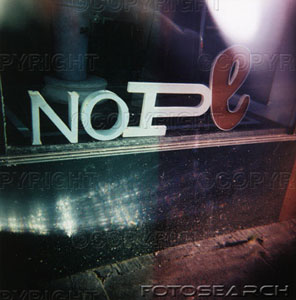
Or maybe sling a fraud allegation at painter Leslie Brack while he's at it?
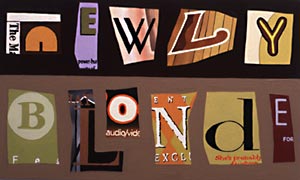
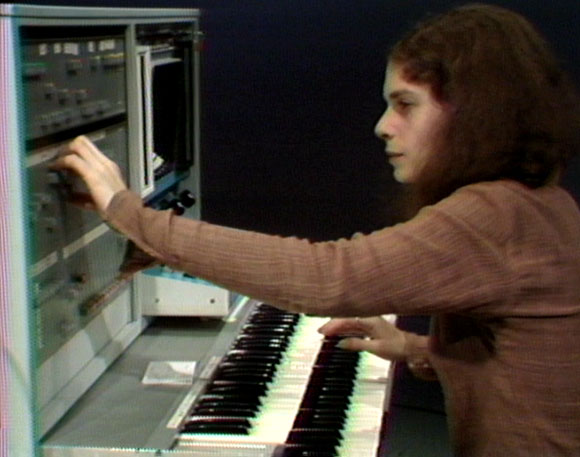
OHM: the Early Gurus of Electronic Music, a 3-CD collection of groundbreaking analog and digital music up to about 1980, was recently re-released with an added DVD. The best moments are the documentary films and interviews; the weakest are the many attempts to wed visual art with music. Highlights:
--Edin Velez's grainy documentary video of Mother Mallard's Portable Masterpiece Company trucking their several tons of Moogs to NY for a live gig in 1976. Their Terry Riley-ish composition "Water Wheel" is heavenly. Three keyboardists play all the "loops" live. Nowadays music like this could be done with a laptop and a freeware sequencer, but it just wouldn't...be...the...same.
--Laurie Spiegel playing the Alles digital synthesizer (PDF), another monster piece of gear from the '70s (see above). Very reedy, pleasantly artificial, FM (frequency modulated) notes issue from this NASA-looking contraption.
--Interview with Bebe Barron, one of the Forbidden Planet scorers, who mentions that Harry Partch had been hired by the studio to do the music and then fired when Bebe and her husband Louis were brought on board. Ouch! Their score is great--still hard to believe something so unmelodic got past the studio heads--but for Partch the loss of cash (if nothing else) can only have hurt.
--Interview with Milton Babbitt, about the early days of the Columbia Princeton Electronic Music Center.
Paul Lansky's score for Grady Klein's animated cartoon "The Dust Bunny" grabs your attention from the first note. The cartoon, resembling Pixar on a budget and chronicling the battle between a robot vacuum cleaner and the eponymous dustball, is too cutesy by half--we've seen this Tom & Jerry schtick so many times it's impossible to make it fresh. Listened to Lansky's music again with the cartoon minimized and realized how much depth it added to the animation. It's film-music-like--at one point recalling Stewart Copeland--but has a life of its own as a composition straddling the post-serial academic and pop entertainment worlds. Also very FM-sounding, with an intriguing lack of "attack transients" (the gritty, white noisy sounds usually heard at the beginnings of notes): the tones were eerily smooth even when the score was at its most boisterous (the sharp attacks all came from the Foley track, a clatter of goofy sound effects done by someone else). Many strange digital synthesis sounds (alien drones, scary glissandos) were slipped into the conventional-style orchestration. There is something very powerful, very melancholy in the music--an undertow, hard to put your finger on.
The visuals on the OHM DVD designed to "go" with music mostly failed to attain its "condition," as a Modernist might say. From tepid "state of the art" computer animation to old-school gelatin-on-the-overhead-projector psychedelia, the imagery was consistently outclassed by the emotional, expressive power of the sounds. Far better examples of synesthetic combinations can be found on the recent Kraftwerk tour DVD Minimum-Maximum, but that's another post.




Probably doesn't matter how well these sync up--though they're likely better with a rhythmic wobble than an arhythmic wobble.
Update, whoa--just saw these on Internet Explorer (I've been using Firefox). They're very much in sync even though two of them are set at 10 frames per second (22 frames in all) and the other two are set at 20 fps (and 24 frames). Further update: I was wrong about IE--I'm getting random behavior with it now.




These look pretty good in sync, so the Safari browser is not recommended! Try Firefox or IE. And God only knows what RSS readers will do to this.




Work in process--still thinking about ways to go with this. Another John Parker flat piece remixed--a pattern of daisy appliques for a bathtub.
Below: Claire Corey, Half Past Autumn II (1Z7), 2006. Corey has a show of digital paintings coming up in Dusseldorf. I like the James Nares meets Street Tag meets Corporate Logo quality of this one. Some complex, glitchy things happen in her work that jpegs can't possibly show--this ain't net art, you have to go to one of them there galleries to see it. Still, this thumbnail works, too.

"Godzilla Scales" [mp3 removed]. John Parker remix of my Mac SE tune. The original tune was a four note chord ascending and descending the scales over the Mac's entire octave range (maybe four octaves? I forget). The computer couldn't keep up with all the changing pitch information so interesting percussive artifacts developed. John has employed some kind of time-stretching algorithm so the chord speeds up and slows down as it changes pitch. The result is exhilirating and strange.
Updated with additional information.
V for Vendetta (the movie): pretty much Hollywood crap as usual, although the anti-Bush and anti-religious right themes are bracing. I'm glad it's a hit if it means people are scared where our new Cotton Mathers are taking us. [Spoilers coming.] The first half sailed along but after Evey is taken into custody by the Finger it took too many shortcuts and liberties with Alan Moore's story and stopped being believable. The mushy movie types were hurt that Moore repudiated the film but good for him! He proved that it's possible to make a strong political argument that's nuanced and intelligent using comic book tropes and they set about disproving him with their usual poll-tested conventional wisdoms. Am re-reading the comic to get the movie out of my brain. Will post some key differences as I read, so this blog entry will change.
In the comic, nuclear explosions have destroyed Europe and Africa. Fascism emerges in England after civil society devolves into chaos. Everyone is poor. Evey is a hooker-in-training and works in a match factory.
In the movie, people have nice TVs and computers, with slick interfaces. Evey is an aspiring actress with smart clothes who works at a TV station. Upper middle class wish fulfullment--a promise to the audience that can never be broken.
The whole "I will return in one year to blow up the Houses of Parliament" schtick is a movie plot contrivance. In the book V destroys Parliament in the first chapter, and destroys Downing Street a year later, unannounced.
Another movie contrivance (probably in Ms. Portman's star contract)--the heroine tries to escape V. In the book she is 16 and much more dependent on him; she stays with him in his lair even after she knows he is a killler.
In the book V is an experimental subject in a concentration camp (as in the movie)--he is driven insane from drug injections and develops godlike powers, including a "strange ability to control people." The whole "developing the virus in the camp" subplot is the filmmakers' hackneyed invention.
Plotwise the film was very confusing leading up to the "blowing up of Parliament." V did all that by shipping around some masks? In the book we learn he had secret access to Fate, the government's main computer array. Well, the masks certainly made for a nice MTV video moment of thousands marching up to Parliament dressed as Guy Fawkes.
In the book V's mischief is the dominant story in a series of interlocking tales about life under a fascist regime, centering on people heading the various government departments--their compromises, betrayals, vices, and tawdry love affairs. It's a very adult "comic." The movie is a juvenile, Beauty and the Beast tale, with simplistic politics.
At the end of the movie, V professes his love for Evey. Just like a Tom Cruise film--a heel learns the healing power of love. V makes the declaration halfway through the book, after he has tortured Evey for months in a fake prison. It's totally creepy--his ideas of freedom and love are Est-like, as coercive and fascistic as the government's. There's none of this "until I met you I thought violence was the only way..." crapola.
In fairness to Moore, his V is a complex character and the book is filled with his thoughts and soliliquys on the "two faces of anarchy" (creator and destroyer). At the end mob violence has returned to the street and it's by no means clear what will replace the authoritarian edifice he has tipped over. In the film the message is Yea! Freedom! Boo! Slavery! which makes the Wachowskis the Tinseltown liberal version of Bush. Spare me from films with "life-affirming values"!
Paul Slocum has an interesting post up about archival issues and art DVDs. We sold two DVDs out of my show at And/Or Gallery, the space he and Lauren Gray run in Dallas (go, us!) and now business details are being attended to. First Paul's post and then my thoughts follow:
With our first show at And/Or I was really surprised to learn that video does sometimes sell — we sold both of Tom’s videos.Both DVDs I sent Paul were editions of five. (They didn't actually have Sharpie writing but nice printed labels.) There are trust issues that go each way between buyer and seller with the sale of multiples, the more so when both parties essentially own the means of production. I remember an artist friend of mine got a detailed contract from a prospective purchaser who was an attorney, trying to limit my friend's rights with regard to future production of a digital print. My friend refused to sign it and the attorney said "Oh, OK" and bought it anyway. I haven't investigated the costs of using the professional replicating houses, but I can't say Paul's way--selling a CD-ROM that allows the (tech-minded) buyer to make replacements--is any less acceptable than having a "pro" burn your DVD and then and then adopting an "all sales final" approach. I don't know what kinds of arrangements the big galleries make for such sales, and would welcome thoughts from anyone who doesn't think this is a taboo subject.
I didn’t really expect the video pieces to sell, so I had to scramble to figure out archiving issues with DVDs. For most artists that we would show, getting a DVD produced would be cost prohibitive, so everything’s going to end up being a DVD-R. And how long these will last is unknown. I’ve read that playing burned media reduces its lifetime. ["I've never read that," Tom says nervously.] I’m not sure this is true, but if it is, DVD-Rs repeating over and over in a collectors home could have short lifespans. And using the wrong kind of marker could reduce its life. [Not Sharpies, I hope. --tm] Or a minor scratch.
Rather than go to great lengths to test DVD-Rs and research all the details of archiving, I’ve decided to take a “fair use” approach instead. First of all, I archive all DVDs that we sell via ISO images. If the collector’s DVD fails, then we can replace the DVD. But as a secondary backup, I burn those ISO images onto a CD-ROM that comes with the purchase, and suggest that the buyer copy this data to their own computer and keep it safe. It seems a bit much to instruct the collector on how to rip a DVD and burn a copy, but if they have the ISO image it’s easy to burn a copy. Maybe this all seems like a little much, but I guess it’s the role of the gallery to figure out this kind of stuff

I cleaned up the previous .mov, replacing most of the olive color with yellow. A little wobbly on the bottom edge, need to recrop the frames: [11 MB .mp4]
Superfast version, no sound: [.mov file stopped working -- thanks, Apple -- here is a 97 KB GIF] <== This is probably the keeper, what I had in mind all along. Viewing it double size is best, if you download it.
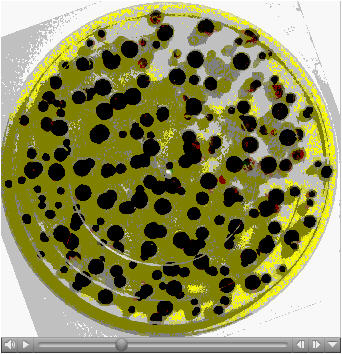
Spinning petri dish-like abstraction with high pitched drone. Letting it loop a few times to get the full lo-fi psych effect of the simulated Brownian movement/cell mitosis is recommended. In other words, your eyes have to acclimate before the Op effects kick in. [11 MB .mp4]
This is work in process--collaborative music pieces done with John Parker based on the tunes I did with the Macintosh SE:
"Toronto 1 (Brakin)" [mp3 removed]
"Toronto 2 (Sadsong)" [mp3 removed]
Another John Parker piece I animated
Update: "Personal 'anti-broadband ghetto' threshold": Just trying to keep the kilobytes per post down on this page, optimally in the 25-65 KB range, so the blog is viewable on dial-up. It's tempting to post higher-res images and more elaborate animations for the broadband elite, but the self-imposed limits for the page (e.g., no image wider than 580 pixels) force thinking in a more economic lo-fi way. [/self-satisfied explanation]
Update 2: The animation this post linked to has been changed to something a little peppier.



"Mutator OD Bass" [1.9 MB .mp3]. The Mutator is an analog filter unit with a very full, liquid sound. It is practically a synth unto itself. This piece uses a couple of repeating bass notes that are transformed by external audio and MIDI signals affecting the Mutator's LFOs and envelope followers. The drums are the only thing added, the rest is the Mutator and mostly done in real time.
(reposted with additional info.)
Update on my upcoming Williamsburg show: the title will be "Room Sized Animated GIFs." We'll be projecting a couple of them big on opposite sides of the room, with smaller ones looping on TVs along a third wall. Friday, May 5, at artMovingProjects.
We changed the date--it was originally Saturday, but the intermittent L train repair shutdowns make that day an iffy proposition in Wmsburg.
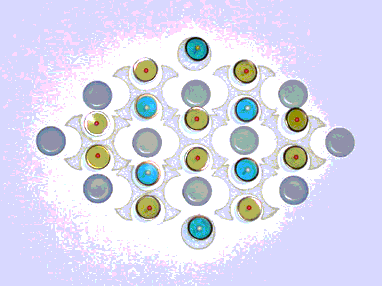
Animation based on John Parker flat work (see below).

This is a piece of mine, not a .GIF based on John Parker's work. I'm using it as reference.
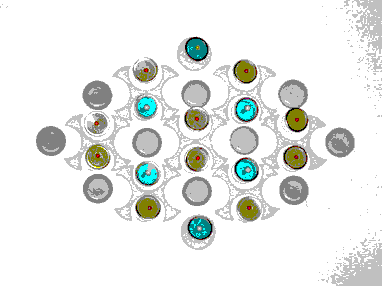
I am working on a collaborative project with John Parker for a show in Toronto. It will be both music and video--details to follow. He has been remixing some of my Mac SE tunes. I'm going to try some animated GIFs based on images of his artwork from his website. We'll see where it goes.
Plug: S.I.D.S. (Sudden Infant Death Syndrome--these kids today and their band names, why back in my day...oh, yeah, whoops) from Athens, GA, is playing at Capone's in Brooklyn tonight, 221 N. 9th, betw. Driggs and Roebling. If you can't make it, check out some of their music at the myspace link above. Punkoid sound featuring overdriven keyboards (with bass, drums and enraged vocals), as opposed to the dreaded ubiquitous g***tar.
There is a place in the far North where the ocean periodically bulges up and actually breaks free of Earth's gravity. A few grazing sheep, the only witnesses, flee whenever this happens. The sea becomes a water moon, flies into the sky, enters a wormhole in the atmosphere, and returns to Earth as a floating Magrittean rock. The rock hits the ground and becomes the Earth, the sheep return, and thus are sea and land always kept in balance. Or at least that's how it seems in this Sally McKay video (be sure to watch the Quicktime--it has suitably understatedly un-apocalyptic music).
This cartoon by Gary Panter makes me laugh. I'd classify it as "stealth stoner" humor. (On the other hand, the title of the strip *is* Smoke Wagon.) I love the way he draws the protagonist bird slightly differently in every panel, with varying degrees of pen nib shakiness. By the third panel we are seriously wondering why this feathered maniac is driving a kiddie jeep from town to town. It also makes me think of the Michael Smith/William Wegman video "World of Photography," which combines wacked-out devotion to a universally available medium with a finely tuned sense of the pathetic.
The Washington Post has a story today about how hard people work at the White House and how exhausted everyone is. Bush chief of staff Andrew Card is especially praised for his "stamina." Steve Gilliard puts this malarkey in perspective:
You know I'd feel bad for them if they weren't incompetent morons getting people killed. Who gives a fuck about Andy Card's schedule. Some kid wakes up in Walter Reed and has to figure out how to live the rest of his life without a leg. So you think Andy Card really has problems?
This makes these people seem more human to the Beltway folks, when to most Americans, they could give a shit. Andy Card could quit tomorrow and be a multi-millionaire betraying America for the Bush family's Saudi friends. If he's tired, he can quit any time. Hopefully, he isn't running a scam on Wal Mart.
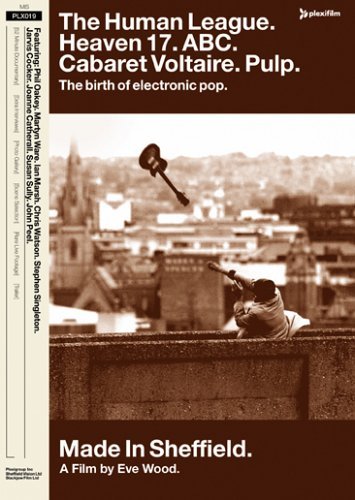
Thinking about buying this DVD. Looking at that picture makes me blissfully happy. I keep waiting and hoping that rock will die. That something will replace the three chords, the verse-verse-chorus, the drum-bass-lead, and the stupid iconic image of the slouching boy or girl clutching the ax as the ultimate avatar of coolness. The early '80s (documented in the film), and then again the early '90s, hinted that it was possible, but stupid cock rock cliches always come back, like the crabs. This blog page is dedicated not so much to the keyboard as an alternative, or even the "dj" (another kind of anti-authority authority figure), but rather abstract, orgiastic, authorless, soundcentric but still tuneful music, the unfulfilled promise of rave. House music, at the very least, with the dj/knob twiddler barely visible behind the record crates.
Now that that's out of the way, please note that Simon Reynolds discussed his book on postpunk last week on Slate.
More WhitCrit, this time from January Blog. I like blogs that talk about work. Yes, Midnight Dusters gets Elaine Sturtevant completely wrong, and mistakes Jutta Koether for Trisha Donnelly, but that's where commenters are helpful (they were right on top of it).
Wednesday I attended the less glamor more clamor, second, "artists'" opening of the Whitney Biennial. My first impression of the exhibition was that it was almost unbearably arch, clever, cold, soulless and ultimately depressing. I hated it. [No second impression is stated so this criticism will have to stand. --tm] The focus of the show seemed to be very much about "issues" that the art world seems to care about, not all of which are formal, but which seem to have little relevance in the world at large (witness Matthew Day Jackson's handmade, kitsch-owl commanded covered wagon with its bonnet of sewn-together state flags and undercarriage of rainbow colored fluorescent tubes). Not to be outdone, the worst work in the show was a series of large fake monoliths by Dan Colen. Giant (6 feet or so high by about the same in circumference) gray zoo-rocks covered in chewed gum wads and graffiti rest on 6" high wooden triangles carved to spell out "phrases from the street" like "eat shit and die." Everything about the objects themselves is overly precious and, like the art direction for West Side Story, completely removed from the physical reality of its ostensible subject matter.That's pretty tough, let's have some more:
Peter Doig's much anticipated paintings were shockingly old-fashioned. [Why shocking? They've always been old fashioned. --tm]
Less devastating is the continued presence of "rock art." Jennifer Allora and Guillermo Calzadilla's Sweat Glands is a large video projection of a lady rocker playing a guitar around a monolithic amp. Maybe it's a 2001 reference? Who cares?Trisha Donnelly, a performance/installation artist from San Francisco,Jutta Koether presents a big room with one panel of silver plastic curtain streamers [in] the middle of the room, a very large Marlene Dumas-ish ink on canvas of a naked woman on one wall, a silver Swiss Ball, perhaps a mirror ball? and a collection of shabbily-made flat-black wood panels with "abject teen" notes pinned to them. I wasn't present for one of the unscheduled performances, which are intended to "disrupt the temporal logic" of the exhibition.
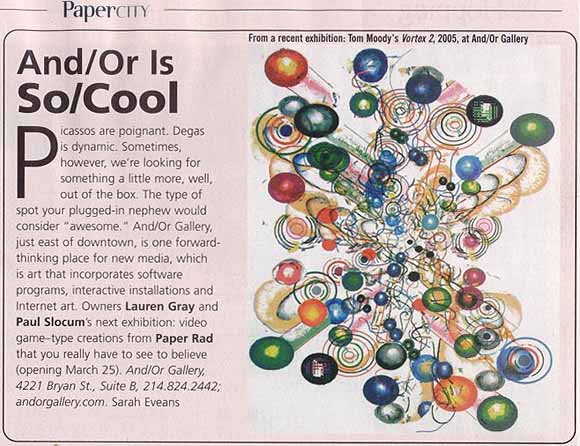
MSPaintbrush in the news again...
It began in a lonely office cubicle in White Plains, NY...long weekends of overtime...a man had a vision that this lowly program could be used to make art...the vision spread...
Yeah, yeah, just BS'ing around. Thanks again to Paul and Lauren for making this show in Dallas happen and for making it so fun to do. I learned a lot working with them, and look forward to continuing collaborations and projects in cyberspace and elsewhere.
AFC sez, about the current Whitney Biennial:
It's hard to get past the feeling that rather than examining current trends, Biennial curators Chrissie Iles and Philippe Vergne began with a set of concerns they were interested in and then sought out artists who met those interests. There's nothing necessarily wrong with this, but it does strike me as an intensely egotistical practice to be making the claim that contemporary art making is about the things you happen to be interested in. Old school political activism is not the pulse of [the] nation.Hear, hear. No, I still haven't seen the show--take this for what it's worth as a preReview. An artist friend who had a frustrating studio visit from Vergne and Iles reports that they didn't look with their eyes, or even their ears, but with their mouths (especially him, and she deferred to him). And what is it with Europeans and the fucking spirit of '68? Catherine David took that same tack with Documenta a while back. Yes, a crazy liberating time for young Parisians, running wild in the streets, believing for a few moments in the possibility of universal socialism---GET OVER IT! I mean, Deep Dish TV? As much of their politics as I might agree with, what they do isn't art, it's political activist media. This is like Larry Rinder touching Rural Studio with the curatorial magic wand a few years ago and saying "I have the power to make you an artist." It's just not fair to people who do art 24/7 and deserve some comprehension. OK, I will shut up until I see the show. We're quibbling about the themes and the people, not the work.
Despite impressive resumes, having heard Iles and Vergne speak I find it hard to believe the curators had a real understanding of what inspired the work they managed to find. The most engaging art in the show often used recycled imagery, or constructed fictional narratives, and the curators forward increased travel as the explanation for this phenomenon. I guess artists with nominal pre-Whitney success are making a lot more money than I knew, because I just assumed travel was as much a credit risk to these people as it is to me.
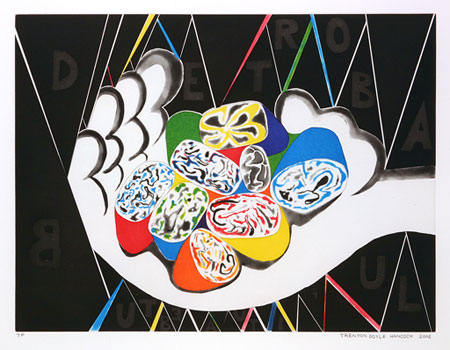
Hadn't made it to Chelsea in a while and returned to find a universe of painting...and pain. The former I attribute to the hordes of well-heeled collectorbots descending on New York for the fairs and looking for "tangible product" (I know this is a frequent jab but there has to be someone we can make fun of). The latter I ascribe to our mass collective psychic residue of guilt over tearing another country to shreds with an elective, unprovoked war, combined with self-expressive narcissism as usual (the crucified Christ c'est moi).
Thus Giles Lyon channeling Steve Mumford's Baghdad Diary by way of Carroll Dunham (and Goya) at Mixed Greens; Michal Rovnar's punishing digital video at Pace recalling a fractal distillation of the oil field fires in Werner Herzog's Lessons of Darkness; bleeding bullet holes in Lucky DeBellevue's chenielle stem sculptures; Bonnie Collura's morphed figures that have grown increasingly gory and angst-ridden since she got raised to Olympian heights and then squashed like a bug by the Times (seriously, they were good, but might have done without the St. Sebastian arrows); Trenton Doyle Hancock's bone-through-the-wrist stigmata bleeding Pepto-Bismol; and that was just on two blocks.
Big shout-out to Jeff Elrod at Fredericks Freiser: punchy but elegant paintings; excellent addition of spray paint and grey check backgrounds a la Photoshop. Not Matisse with a Mac (as an old press release had it), so much as Cy Twombly. And kidding aside, that Trenton Doyle Hancock show at James Cohan (image above) is superb: a splattery gutfest with pitch-perfect balance of outsider-y collage elements and geometric tangles of bones and viscera. He takes pages from the Christian Schumann playbook, wads them up, spits on them, and glues them back on the canvas in a thousand pissed-off fragments. (Speaking metaphorically here.)
Updated: "Blues Vector" [3.6 MB .mp3]. The tune formerly called "Two Minute Drum Solo"--I thought it needed a slightly sylvan, deconstructed blues riff wafting in over the top, so I added that. "Vektor" is the preset on the Reaktor instrument Subharmonic used to play it. Changing the subject somewhat--finally learned how to make that "drill and bass" drum sound--it's just MIDI notes playing one sample many times in rapid succession--so now I don't need to do it any more.
"Blues Vector (Drums)" [mp3 removed]. What I originally posted.
I may change the title yet again: "Blues Vector" gets at what I am trying to accomplish with the piece but maybe is too ordinary, or pretentious.
Update: Reposted "Blues Vector" with volume maximized, 2009

"If you get excited by words such as analog and vintage, look away now. Oki Computer 2 is a compact wavetable synthesizer, a specialist in digital lo-fi sounds that hails back to the 8-bit era of beeps and bleeps... It is also rather capable of creating buzzing leads, rhythmic sequences, and odd tasty bass tones."
Brochure copy for a Reaktor Instrument designed by James Walker-Hall and Timothy Lamb, a kind of softsynth Sidstation with a more up-to-date sound. Music composed (mainly) using the Oki 2 can be heard on the Reaktions website. Some beautiful stuff here. This is the digital bleeding edge and the fact that it's commercial, licensed software is offset by the cultish climate of serious producers pushing each other in a critical environment of chatboards, non-commercial websites, etc. The music is very much a collaborative effort by individuals (artists, designers, preset crafters) trying to pull unique sounds out of that everyday, chip-laden plastic box sitting on your lap or under your desk. My favorite piece is "Progression 7819" by spr: one reviewer compares it to the Akira soundtrack, to which I would add it's doomy and Ryuichi Sakamoto-ish, with sputtering human beatbox-style (but still subtly digital) percussion. More on the abstract side but still lyrical are ZooTooK's Brian Enoid "Oki Compis 2," ElektrikZen's "Okiko," and Dongle Doc's "OKOK." I like the slowed-down psy-trance of Jason Wolford's "Systoric," and Damon Vallero's "Oki the Rainbow" has some nice chords reminiscent of Larry Heard sans the house thump. And lest this sound too much like a Native Instruments infomercial, I do find Oki (and Reaktor in general) more convincing as a flavor than a universe unto itself. On many of these pieces one yearns to hear some "bottom," something more "phat," not because the analog purist position is superior but because stronger pieces spring from contrasts and tensions.
This is from Matthew Barganier at antiwar.com. Quoted in its entirety because it's a great takedown of a pompous, war crime-enabling ass:
Andrew Sullivan's Song of HimselfAndrew Sullivan – for whom every topic is ultimately just another opportunity for navel-gazing – offers his mea sorta culpa. Let's have a mercifully abridged look:
In retrospect, neoconservatives (and I fully include myself [We know, Andrew, we know - Ed.]) made three huge errors. The first was to overestimate the competence of government, especially in very tricky areas like WMD intelligence. The shock of 9/11 provoked an overestimation of the risks we faced. And our fear forced errors into a deeply fallible system.
I was too trusting, too shocked, too afraid – too, in a word, human. Uh huh.When doubts were raised, they were far too swiftly dismissed.
Were raised? Did they just wash ashore at high tide, or were they raised by the very people Sullivan has been calling traitors and dupes for the past four years?[T]he miraculously peaceful end of the cold war lulled many of us into overconfidence about the inevitability of democratic change, and its ease. We got cocky. We should have known better. The second error was narcissism. America's power blinded many of us to the resentments that hegemony always provokes.
Ah, now we're getting somewhere. Could this be some sort of epiphany about empire and intervention? Get real:Sometimes the right thing to do will spawn backlash, and we should do it anyway. But that makes it all the more imperative that when we do go out on a limb, we get things right. In those instances, we need to make our margin of error as small as humanly possible. Too many in the Bush Administration, alas, did the opposite. They sent far too few troops, were reckless in postinvasion planning and turned a deaf ear to constructive criticism, even from within their own ranks.
Like from me, Andrew Sullivan! I always said we should get things right!The final error was not taking culture seriously enough. There is a large discrepancy between neoconservatism's skepticism of government's ability to change culture at home and its naivete when it comes to complex, tribal, sectarian cultures abroad.
I'll give Andy a congratulatory "duh" on that one.We have learned a tough lesson, and it has been a lot tougher for those tens of thousands of dead, innocent Iraqis and several thousand killed and injured American soldiers than for a few humiliated pundits.
But this self-effacing essay for Time magazine will help to even the score.The correct response to that is not more spin but a real sense of shame and sorrow that so many have died because of errors made by their superiors, and by writers like me.
First rule of neocon punditry: by taking meaningless "responsibility" for the bad consequences, you can logically take credit for the allegedly good ones. But you must first remind the audience that there was really no better choice than the one you advocated:All this is true, and it needs to be faced. But it is also true that we are where we are. And true that there was no easy alternative three years ago. You'd like Saddam still in power, with our sanctions starving millions while U.N. funds lined the pockets of crooks and criminals? At some point the wreckage that is and was Iraq would have had to be dealt with. If we hadn't invaded, at some point in the death spiral of Saddam's disintegrating Iraq, others would. It is also true that it is far too soon to know the ultimate outcome of our gamble.
Yeah, those goddamn French were probably just pissed at us because they wanted to invade Iraq, but we beat them to it. And this too-soon-to-know-the-ultimate-outcome bit is a moral monstrosity cloaked in banality. It's NOT too soon to know the ultimate outcome of "our gamble" (what did Sullivan put on the table?) for the scores of thousands already dead. What Sullivan is saying is that if the Iraqis ever manage to overcome the suffering inflicted on them by the War Party (including its years of supporting Saddam), then Sullivan will accept their humble thanks. Think I'm being too harsh? Well, here comes, as Andy might say, the money shot:What we do know is that for all our mistakes, free elections have been held in a largely Arab Muslim country. We know that the Kurds in the north enjoy freedoms and a nascent civil society that is a huge improvement on the past. We know that the culture of the marsh Arabs in the south is beginning to revive.
Blah, blah, blah. But, in conclusion, how does Andrew Sullivan feel about all of this?Regrets? [Cue Sinatra. - Ed.] Yes. But the certainty of some today that we have failed is as dubious as the callow triumphalism of yesterday. War is always, in the end, a matter of flexibility and will. And sometimes the darkest days are inevitable--even necessary--before the sky ultimately clears.
What a friggin' hack.

Continuing the thread about interactivity... The 1995 interactive movie Mr. Payback, in which audiences voted with buttons on their chairs to determine the outcome of various plot points, flopped big time. As an IMDb commenter described it: "Like when someone is being tortured--you have three options to pick from on HOW he was to be tortured." Another IMDb scribe reports: "Half of the fun was everyone shouting at the screen how to vote when it came up, and using joystick fingers to machine-gun press the buttons to vote for your choice. It only gave you a couple of seconds to vote for your favorites, and it would tally the votes in real time on the screen."
The concept harked back to a Czech experiment/goof from the '60s, the Kinoautomat, which had more subversive things on its mind than just deciding how someone was going to be tortured:
Raduz CinceraI actually saw the Kinoautomat as a kid and it was the most fun I ever had in a theatre (next to The Fearless Vampire Killers).
Kinoautomat: One Man and his Jury
At the Expo of 1967 in Montreal, Raduz Cincera presented for the first time to a larger audience the Kinoautomat (movie vending-machine) he developed together with the directors Jan Rohac and Vladimir Svitacek, scenographer Josef Svoboda, and Jaroslav Fric and Bohumil Mika. It involved the world’s first interactive movie theater. In the movie theater’s seating, viewers found two buttons necessary for making selections; they were confronted with a film whose action could always be stopped. At one point, two principal actors from the screened film appeared onstage and asked the audience how they thought the scene should be continued. The viewers decided; afterwards, the [desired] film version, arrived at by public vote, was then screened. The film One Man and his Jury told the story of an "average apartment house," with turbulent goings-on between tenants. In one scene, a young woman [locks herself out of her apartment] after checking to see who rang her doorbell. Since she was in the shower, nothing covers her body except a towel. In her panic she rings her neighbor’s door and asks for help. Here the film is stopped. The audience is asked whether the neighbor should let her in or not. In almost every case the majority of the viewers answered yes. Only once, at the Expo, did the viewers vote no—when the scene involved a large group of nuns.
"The branching structure wasn't tree-like, doubling the number of scenes needed at each choice, but rather always remained only two. They did this by carefully crafting a story such that no matter which of the two options were chosen, it would end up back at the same next choice. The vote was executed by the projectionist switching one lens cap between the two synchronized projectors. The artfulness, ultimately, was not in the interaction but in the illusion of interaction. The film's director, Raduz Cincera, made it as a satire of democracy, where everyone votes but it doesn't make any difference." (Quote from: Michael Naimark, Interactive Art - Maybe It's a Bad Idea, 1997)
Rudolf Frieling

Jim Finn, Chicago: "This is a needlepoint recreation of a spacesuit patch for the international communist space program based in the former USSR. The Interkosmos program began in the 1970s as a way to integrate socialist and non-aligned nations into the Soviet space program; it brought cosmonauts from Cuba, Mongolia, Hungary, Vietnam, East Germany and Syria among others into space. I used this patch in my film Interkosmos, about an East German space colonization mission to the moons of Jupiter and Saturn. The needlepoint patch is featured in the Amber space capsule headed for Ganymede, one of the four Galilean satellites of Jupiter. The writing on the patch is the Russian name for Interkosmos."
From an online exhibit of objects made using the microRevolt website's software, which converts jpegs and other image files into stitchable patterns. This patch is considerably more detailed than the PDF of the pattern linked to on this page, it should be noted--it appears the PDF was only used as a rough guide. See Paul Slocum's "bad jpeg" microRevolt cross-stitch pattern and my cowbug.

Daniel Gottin (umlaut over the o not reading in RSS): "I am interested in a work that makes the site visible through the art work, and the site makes the art work visible at the same time. It is about the consciousness of perceiving something. It is a communication, a give and take between equal parts creating a new, balanced entity."

Update: The link to these images is dead. Way to go, Minus Space!
"Prophet and Lossy" [mp3 removed]. I did this in 3/4 rather than the usual 4/4 and added some exciting key changes in the second dropout! I might snip out a bar or two at the beginning; still thinking about that.
Mailbox
Hey Tom,
I've been thinking about interactivity in art lately, which I think is a bit of a divider into two camps of new media artists. Seems like most of the artists I'm into don't use interactivity that much. But there are some artists who always do and almost seem to consider "interactive" and "new media" to be synonymous. But a lot of the interactive stuff I see, I don't totally get why it's interactive. Seems like if it is interactive, there should be some really compelling reason to make it so, and the interface is extremely important. Otherwise it starts to feel like it fits better in the Museum of Science and History than the art museum.
My main question is: where do I look for a history of interactive art? Any particular artists to check out? Surely there was interactive work before computers, and maybe even an early interactive "movement"? Or maybe it is relatively new? --PS
Dear PS,
"Interactive" is one of those buzzwords like "multidisciplinary" that grant panels love. I've always been critical of art that feels like it belongs in the Exploratorium. (Until 20 years later, when it becomes great kitsch.) Agreed, some (most?) new media artists require interactivity, no matter how dumb or pointless, for admittance to the Club. One computer gallerist calls me a Modernist because I believe in "stand alone" art. It's not so much a belief system as feeling that certain things are right for certain venues. I'll sit at home and click a mouse surfing for hours but resent it when someone puts a mouse on a ledge in a gallery and expects me to start navigating something to "get" the art. The gallery is better for a "heads up," moving around experience, movies are better for long narratives, and your computer at home is best for "net art." The art should fit the physical environment and the expectations of that environment.
Historically interactivity started in the '60s with kinetic art and holography, and the "anti-object" ideas of conceptualism. Michael Fried's famous essay "Art and Objecthood" was one of the first to identify what he called "theatricality" in art. But there's a big difference between the theatricality of moving around a Minimalist sculpture and thinking about how your body and the room define the experience--which was a good thing to learn--and the obligatory joystick with a sign that says "Join me in 'making' the art according to 7 preset menu choices!" After the '60s, computer science departments started grafting half-baked versions of conceptualist and minimalist concepts onto the emerging net art and robotics art fields. Thus, what we have today. I try to be open about stuff, but always ask "What purpose does this interactivity serve?"
--Tom
(I dodged the question about specific artists practicing interactivity--any contributions to an etymology of the term would be welcome.)
More Mailbox
Hey, Tom,
I've been meaning to ask you about your RSS feed. In my news reader (bloglines) your blog almost always shows new content, even when I've already read the posts. After I read them they show they've been read, then the next hour they show up as new again...I'm wondering whether your RSS feed has some strange autonewness feature, or whether it's just that you go in and change a typo or something and the old post inadvertently gets tagged as a new post.
[N]o big deal either way, but your blog is the only one I monitor that does this. --DR
Dear DR,
I rewrite the posts a lot. Sometimes the meaning changes as I rewrite and refine what I originally posted. Sometimes I find egregious, embarrassing typos. I don't always write "updated" at the bottom so it may seem Orwellian to some that the content changes. One person was slightly shocked to learn about this tinkering but said it was "between me and my conscience." Where's the rule book exactly?
Anyway, if the RSS is showing those revisions--or at least flagging that revisions have occurred--that's actually a true reflection of how the page evolves.
If other bloggers don't do this it's entirely possible they never revise their pages. God knows I see a lot of pages that need to be revised. --Tom
Dear DR (followup email),
I have another site--tommoody.us--which is a Word Press blog unaffiliated with the Tree. I just revised a post there as well as on my Tree page. Bloglines showed both as "new posts." So it's not the Tree's /xml feed. I wonder if it's configurable on the bloglines side--that is, if you could tell it not to notify you of updated posts?
Thanks for bringing it to my attention--people are probably irked by my constant revision. I think this proves that no one else is revising their text, that's why you don't see it.
Amazing blog slobs.
--Tom
Dear DR (second followup),
Just looked more closely at my own bloglines subscription. Under "edit subscription" there is an option "Ignore Updated Items." For mine I had evidently chosen "Updated Items--Display as New" at some point (don't remember doing it). If anyone chose "Ignore" and is getting new post notifications, please let me know.
--Tom
Onion interview with director Whit Stillman: he's dry, self-effacing, and funny, just like his movies:
AVC: To extend the Citizen Kane analogy, you were nominated for a Best Screenplay Oscar [for Metropolitan] on your first try, just like Welles.Or later:
WS: I like these analogies. [Laughs.] But my idea was that The Last Days Of Disco was going to be the Citizen Kane of romantic comedies. [Laughs.] I like to defend Disco because it got a beating in some corners.
AVC: Why do you think that was? Why didn't people respond to it?
WS: I think I touched the third rail of popular culture, which one should never do. The third rail of cliche. A lot of people had very firm ideas of what disco was. They weren't my ideas, nor what I wanted to show. And then I later found out that many of the people who were so authoritative about how our disco period wasn't "real" disco had no information of their own. They were just going from having seen Saturday Night Fever or something. I imagined these journalists lambasting us for inaccuracy to all be habitues of Studio 54. No, not at all. [Laughs.] They would all preface their comments with, "Well, in that period, I only liked punk music. I hated disco. But this film is not..." Whatever. Anyway. For me, it was exactly as it was in my head.
AVC: Those scenes in The Last Days Of Disco work a lot like the closing scenes in Metropolitan and the closing scenes in Barcelona, in that they all introduce a note of hope into movies that are about a golden era coming to an end.
WS: For me, the present is a golden era that's ending too. That's the greatest golden era. Right now. [Laughs.] I just like pining for lost times. I can pine for this morning.

This lovely bear in the woods image was made with MSPaintbrush--the old one, pre-Paint, the one I use, but never this lyrically. Travis found it in this gallery (I couldn't view it in Firefox, had to switch to IE). He's been digging up some great drawings made with these simple paint programs.
On the opposite end of the Internet art content spectrum, check out Karl Klomp's glitch videos ("It seems much of his glitch output, and very tasteful it is too, comes via repurposing video mixers or even burning DVD’s with 'impossible bitrates' for challenged DVD players to read," says dataisnature) and prints.
Meanwhile, back in the real world, looks like the Whitney is rehashing Gordon Matta Clark and the spirit of '68 again, based on this Times review of the 2006 Biennial and other reports. I promise to keep my mouth shut and mind open till I see it, but till then, I'm groovin' on that bear.
A friend has been talking about remixing some of my early tunes done with the Macintosh SE. This gave me a push to re-record some of them from the original cassette tapes. All of the below were posted a couple of years ago, but most of these new (old) recordings sound a bit punchier now. Besides the Mac (which has a very primitive "8-bit" sound) I used a few lock grooves (and um, "found" beats) from vinyl records playing on turntables, saying a short prayer that everything would stay in sync.
1998 - 2004
1. Scratch Ambulance [3.7 MB]
2. Phil's Revenge (TM vs Ectomorph) [2.1 MB] / hi-fi [2.6 MB]
3. Brakin' 1 [1.8 MB]
4. Brakin' 2 [2 MB]
5. Calypsum (TM vs M. Mayer) [3.3 MB]
6. Migrant Song [2.3 MB]
7. Streetsong (TM vs 8BCS) [2.84MB]
8. Eins Zwei Drei (Melody) [mp3 removed]
9. Monster Scales [1 MB]
11. Robot Landscape [3.6 MB]
1988
1. Arpeggiasm [2.6 MB]
2. Dance of the Nematodes [3.3 MB]
3. Lament for a Treefrog [1.8 MB]
4. Life in the Mortuary [1.1 MB]
5. Pass the Amphetamines [1.5 MB]
6. Spring Has Sprang [1.2 MB]
7. The Organist Died [.9 MB]
Speaking of clones, here are some Lawrence Lessig articles on what he's calling the "Read-Only Internet"--for example, the Apple iTunes store--a one way street where the consumer plunks down money and gets a product. Opposed to this concept is what he calls the "Read/Write Internet," a world of collaborative creativity that famously includes mashups, remixes, and MAVs (music with anime visuals), but is in fact closer to the openness of the pre-digital era, before every "reading" became a "copying." The read/write milieu is in increasing danger of disappearing as the money folks tighten their grip.
DRM (so called "digital rights management"--could also be called "don't remix me" or "die, revenant masher-uppers" ) is a related means of slowing creativity to a crawl. The egregious Sony CD "protection" scheme, which actually put crippling, virus-attracting malware on people's computers without their knowledge, has been much discussed. But it's also showing up in little ways that are a drain on time and energy.
I realized this as I was trying to move files between computers--certain .avi files created in a particular program couldn't be dragged directly from Computer A to Computer B without first being deposited in a "Shared Folder" on Computer A. For Windows nerds, you couldn't just make the source folder available to the network by right-clicking it and picking that option in "Sharing and Security," you had to use the preset folder with the word "Shared" in it.
So if you're transferring several hundred (other easily transferrable) files and the transfer hangs up for those .avis, it takes time and detective work to go back and figure out what got moved and what didn't. The culprit appears to be Camtasia Studio--thanks guys, who gives a crap about your .avis? I'm guessing that because it's a capture utility they had to promise the movie industry that clips couldn't be easily shareable. Can't have people out there promoting movies and creating buzz by passing around clips, can we?
Similarly, the movie player Intervideo WinDVD on my 2002 computer has a "frame capture" button, which made it easy to generate stills for the Web and to make animated GIFs. Kiss that one goodbye--it's not on the 2005 WinDVD. Movie folks snapped their fingers, said uh-uh, I'm guessing. "We'll do our own shitty PR, thanks."
I would predict vintage computers and software would have increased value for remixers by virtue of being pre-DRM, but that gear is slower and older formats are also hard to work with because they go out of date. So, unless you have serious cracking skillz, the ownership class will increasingly have us by the short hairs, as they say.
Update: The company that makes Camtasia Studio emailed to say the product has no digital rights management. Still waiting to find out why the .avis it creates aren't easily movable between PCs and why a friend can't open them in iMovie (which imports .avis).
Attack of the Clones
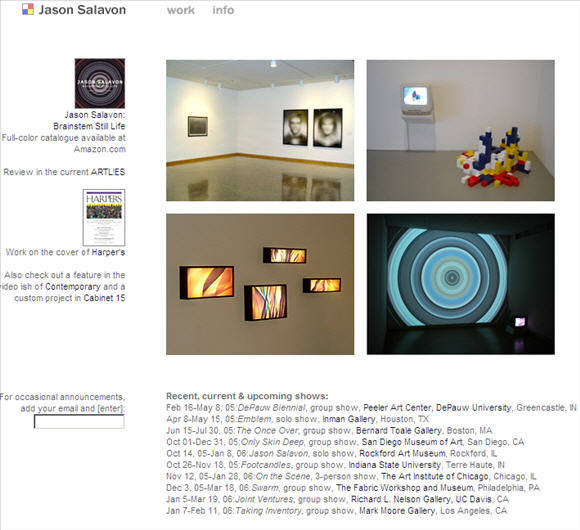
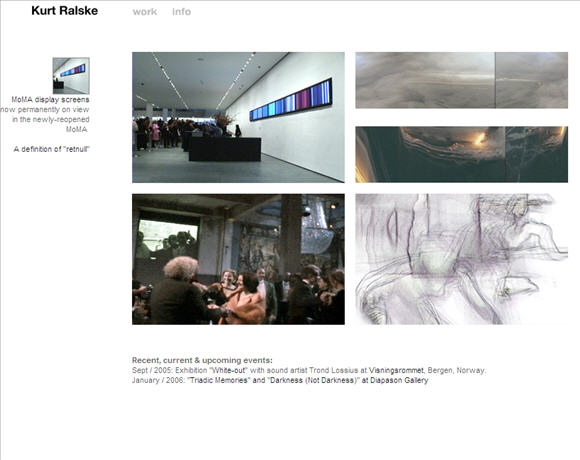
I'm pleased to announce I'll be having a solo show in May at artMovingProjects, in Williamsburg (Brooklyn), NY. Mike Ballou, whose work I've liked since seeing his show of mutated toys on corrugated cardboard ledges at Postmasters a while back, is slated for the Project space. [Update: the Project space assignment is being reshuffled.]
And as if enough personal horn-tooting doesn't go on around here, here's a scan of the Fort Worth Star-Telegram review of my Dallas show with Saskia Jorda, ending this week (yes, I already posted the article, but this is the all-important print edition). As they say, "the best museums in Dallas are in Fort Worth" (the Kimball, etc) and it seems the most conscientious writing on Dallas also comes from there.
